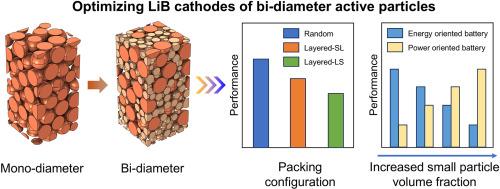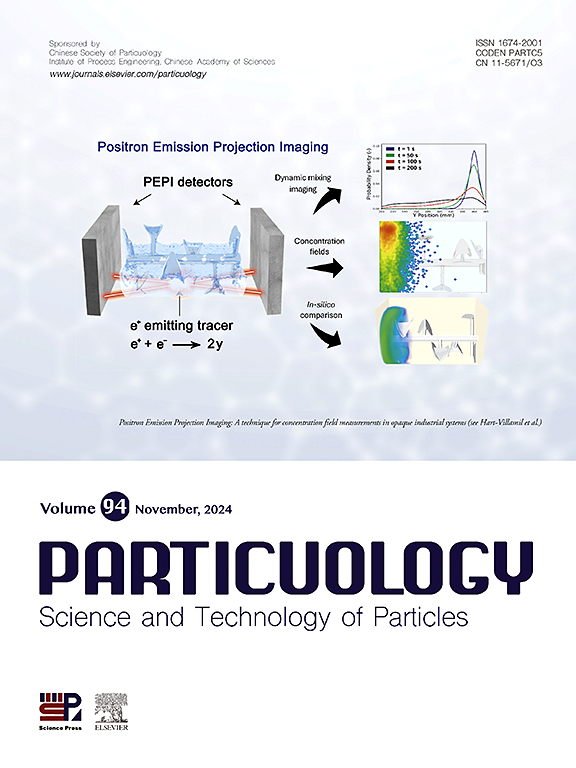Optimization of LiB electrode with bi-diameter active particles using a microstructure-resolved model
IF 4.1
2区 材料科学
Q2 ENGINEERING, CHEMICAL
引用次数: 0
Abstract
The microstructure of electrodes significantly affects the performance of lithium-ion batteries (LiBs), and using bi-diameter active particles is a simple but effective way to regulate the microstructure of commercial LiB electrodes. Herein, to optimize the LiB cathode of bi-diameter active particles, a microstructure-resolved model is developed and validated. The results indicate that randomly packing of bi-diameter active particles is optimal when the electrolyte diffusion limitation is mild, as it provides the highest volume fraction of active materials. Under strong electrolyte diffusion limitations, layered packing with small particles near the separator is preferred. This is because particles near the current collector have a low lithiation state. Besides, optimizing the random packing can further improve the energy density. For energy-oriented LiBs, a low volume fraction of small particles (0.2) is preferred due to the higher volume fraction of active materials. For power-oriented LiBs, a high volume fraction of small particles (0.8) is better because it reduces diffusion limitations. This work should serve to guide the optimal design of electrode microstructure for achieving high-performance LiBs.

利用微结构分辨模型优化具有双直径活性颗粒的锂电池电极
电极的微观结构对锂离子电池(LiBs)的性能有很大影响,而使用双直径活性颗粒是调节商用锂电池电极微观结构的一种简单而有效的方法。为了优化双直径活性颗粒的锂电池正极,本文开发并验证了一种微结构分辨模型。结果表明,当电解质扩散限制较轻时,双直径活性颗粒的随机堆积是最佳的,因为它能提供最高的活性材料体积分数。在电解质扩散限制较强的情况下,最好在分离器附近采用小颗粒分层填料。这是因为集流器附近的颗粒具有低锂化状态。此外,优化随机填料还能进一步提高能量密度。对于能量导向型锂电池,小颗粒的体积分数(0.2)较低,因为活性材料的体积分数较高。对于功率型锂电池,小颗粒的体积分数越高(0.8)越好,因为这样可以减少扩散限制。这项工作将有助于指导电极微结构的优化设计,从而实现高性能锂电池。
本文章由计算机程序翻译,如有差异,请以英文原文为准。
求助全文
约1分钟内获得全文
求助全文
来源期刊

Particuology
工程技术-材料科学:综合
CiteScore
6.70
自引率
2.90%
发文量
1730
审稿时长
32 days
期刊介绍:
The word ‘particuology’ was coined to parallel the discipline for the science and technology of particles.
Particuology is an interdisciplinary journal that publishes frontier research articles and critical reviews on the discovery, formulation and engineering of particulate materials, processes and systems. It especially welcomes contributions utilising advanced theoretical, modelling and measurement methods to enable the discovery and creation of new particulate materials, and the manufacturing of functional particulate-based products, such as sensors.
Papers are handled by Thematic Editors who oversee contributions from specific subject fields. These fields are classified into: Particle Synthesis and Modification; Particle Characterization and Measurement; Granular Systems and Bulk Solids Technology; Fluidization and Particle-Fluid Systems; Aerosols; and Applications of Particle Technology.
Key topics concerning the creation and processing of particulates include:
-Modelling and simulation of particle formation, collective behaviour of particles and systems for particle production over a broad spectrum of length scales
-Mining of experimental data for particle synthesis and surface properties to facilitate the creation of new materials and processes
-Particle design and preparation including controlled response and sensing functionalities in formation, delivery systems and biological systems, etc.
-Experimental and computational methods for visualization and analysis of particulate system.
These topics are broadly relevant to the production of materials, pharmaceuticals and food, and to the conversion of energy resources to fuels and protection of the environment.
 求助内容:
求助内容: 应助结果提醒方式:
应助结果提醒方式:


